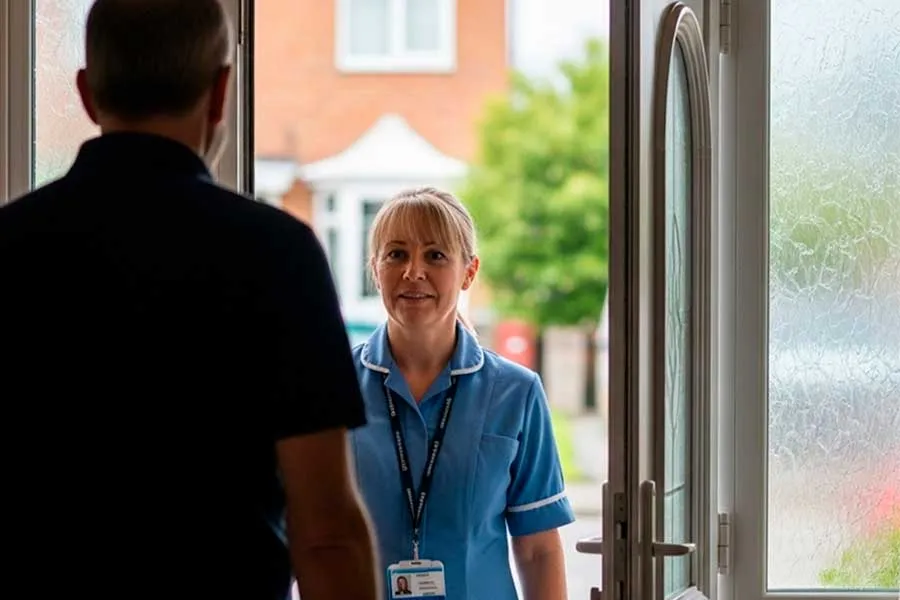As more care shifts into the community, nurses are facing new and serious safety challenges. How can the NHS protect staff delivering vital care in patients’ homes and on the move?
Providing treatment “closer to home” exposes community-based nurses to a unique set of risks.
Nursing Times and Unison research highlights the scale of the problem:
- 93% of nurses have experienced physical violence during their career;
- 74% do not feel safe from violence at work;
- 61% have considered leaving nursing due to safety concerns.
For nurses delivering care alone, often in unfamiliar and uncontrolled settings, the severity of any incident is amplified.
The dangers of entering patients’ homes
Every home visit is unpredictable. Senior figures within trusts across the country have highlighted seeing a rise in the number of reports of weapons, dangerous dogs and extended family being present.
Nurses may be stepping into situations involving mental health crises, substance misuse or family conflict. Even in familiar households, new visitors, behavioural changes or environmental hazards can quickly increase risk.
In most trusts, staff will be required to work in deprived areas, encountering patients facing significant social and economic challenges. While empathy is essential, these very circumstances can create safety hazards.
Unlike in a hospital, there are no colleagues or security staff nearby. Nurses must continually assess threats while attempting to provide care. Often, staff feel compelled to put themselves at risk to complete tasks. As one nurse shared: “I visited a patient alone to take a blood test, and he was in the house with five friends all smoking weed.”
There is a systemic cultural mindset that prioritises completing jobs over personal safety. Community-based staff need to be empowered to say no instead of putting themselves at risk.
How does travelling increase vulnerability?
Community nurses can travel 30-50 miles on a typical day between appointments. These journeys often involve travelling through isolated and unfamiliar areas where mobile signal can be patchy, making it difficult to call for help in an emergency.
Travelling alone also makes staff more visible targets for harassment or theft, particularly when transporting controlled medicines. Finally, driving frequently, particularly late at night or in adverse weather conditions, increases the risk of road traffic incidents and vehicle breakdowns.
With all this travelling around, how does anyone know where community nurses are to ensure their safety?
Why current safety systems aren’t working
Despite the known risks, many NHS trusts rely on platforms such as Microsoft Teams or WhatsApp to check on staff safety and wellbeing. These systems are not designed for safety monitoring.
The shortcomings are significant:
- Manual dependence: staff must remember to check in and managers must notice if they don’t;
- Slow response: in an emergency, managers may not know where a nurse is, delaying support;
- Coverage gaps: poor mobile signal or vague GPS data makes precise location tracking unreliable;
- Admin overload: temporary and agency nurses are often left without protection during onboarding delays.
Being in these situations on a regular basis without support can negatively impact mental health and confidence.
Supporting community nurses with technology
Peoplesafe offers a purpose-built safety service designed to mitigate risks faced by frontline healthcare staff working alone. Our technology ensures nurses feel safe during their shift knowing that they have support at the push of a button. If an incident occurs, a professional service knows where they are, and help can be sent to the right place without delay.
Using Peoplesafe, nurses can easily check in and out of their workday or specific tasks and move away from error-prone and onerous manual check-in processes. Managers and team leaders can quickly highlight any missed check ins or check outs and prioritise their time effectively, simultaneously reducing a huge administrative burden.
Travelling can make community nurses feel vulnerable – whether its commuting at unsocial hours for a shift or driving between appointments. One staff member we spoke to shared: “Someone was following me on my way home from work late evening and I felt uneasy and scared of what might happen as there was no one else about. I went down a street and once around the corner I ran the rest of the way home.”
Travelsafe by Peoplesafe addresses this safety concern by providing continuous journey monitoring via our app, helping to ensure staff arrive safely at each destination.
Why protecting nurses protects patients
Community nurses are often the first point of contact for patients outside hospital. If they don’t feel safe, care delivery is compromised.
Personal safety technology offers a dual benefit: for staff it gives them confidence that they’re not alone, even when working in isolation. For managers it reduces their administrative workload, offers reliable oversight and provides faster response times in emergencies.
One NHS trust leader summed it up: “Our staff now have more confidence knowing that help is at hand should it be necessary to activate the device.”
The risks facing community-based nurses are not new – but neither are the solutions. Protecting staff must be at the heart of NHS planning for the future of care.
Download the full guide, On the Frontline: Managing Risk in Community Nursing, to explore the challenges and the technology that can help: Download the guide here.


